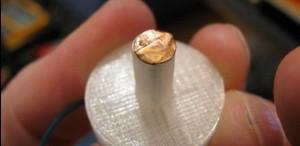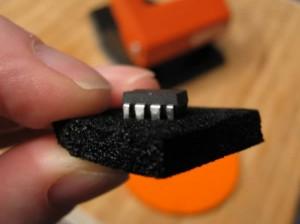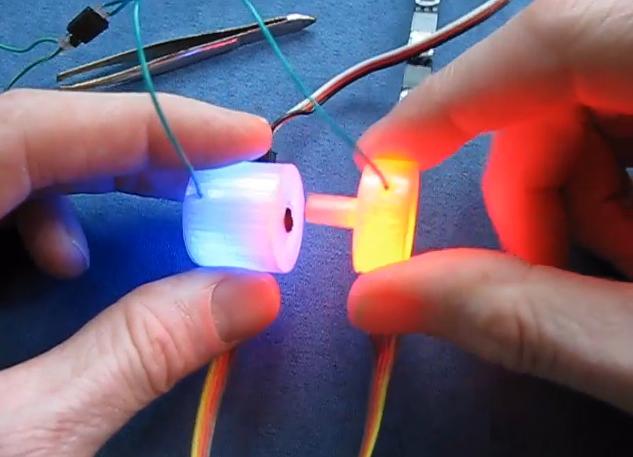Let’s Make Robots is a free, volunteer-based initiative started in 2008 and now entirely produced and maintained by members of their community, and they have lots of cool projects which rely heavily on 3D printing on the site.
Now Gareth, a very active member of the site, has done a demonstration of how to make a simple, 3D printed touch sensor with what’s called ‘conductive foam.’
Conductive foam is most often used to protect integrated circuits from static electricity and it’s generally found wrapped around the circuits for shipping, but it’s not just shipping material; it has some very interesting resistance properties.
 Conductive foam acts as a resistor, but not only a resistor, it can also be a ‘variable resistor’ – or a resistor whose value depends on how much it is being compressed.
Conductive foam acts as a resistor, but not only a resistor, it can also be a ‘variable resistor’ – or a resistor whose value depends on how much it is being compressed.
Gareth’s project takes advantage of the foam’s property to create an accurate – and repeatable – pressure sensor switching system.
The project uses two 3D printed parts as the body of the pressure sensor unit, and the pair of contacts are placed at either end. Small copper strips are sandwiched around the conductive foam to create a displacement resistance version of a touch sensor.
 The sensor can be hooked – via an analogue input – to any of the common MCU chips like the Parallax Propeller, Arduino, Picaxe, or Raspberry Pi. Gareth used CAT5 Ethernet inner wires soldered onto each of the copper disks, fed the wiring into the 3D printed base and plunger, and after some tweaking to get just the right degree of ‘touchiness’ or resistance value, voilà!
The sensor can be hooked – via an analogue input – to any of the common MCU chips like the Parallax Propeller, Arduino, Picaxe, or Raspberry Pi. Gareth used CAT5 Ethernet inner wires soldered onto each of the copper disks, fed the wiring into the 3D printed base and plunger, and after some tweaking to get just the right degree of ‘touchiness’ or resistance value, voilà!
 The two 3D printed parts are made to move inside each other like a hydraulic ram to compress the conductive foam in between them, and Gareth says you can make it happen even if you don’t have a 3D printer. He says the system could be replicated with a straw and toothpick.
The two 3D printed parts are made to move inside each other like a hydraulic ram to compress the conductive foam in between them, and Gareth says you can make it happen even if you don’t have a 3D printer. He says the system could be replicated with a straw and toothpick.
You can download the 3D printable files from Thingiverse. You can see Gareth’s other projects here or a whole bunch of excellent demonstrations on his YouTube page.
3D printing and readily available materials are being used by makers every day to create novel and inexpensive devices. What do you think of this pressure sensitive switch made from conductive foam by Gareth of Let’s Make Robots? Have you ever used 3D printing to make an electronic device? Please weigh in with your opinion or show us something you’ve made with 3D printing on the Conductive Foam and 3D Printing forum thread on 3DPB.com.
Subscribe to Our Email Newsletter
Stay up-to-date on all the latest news from the 3D printing industry and receive information and offers from third party vendors.
You May Also Like
3D Printing Unpeeled: BMF 510(k) & SprintRay Midas
Boston Micro Fabrication (BMF) got U.S. Food and Drug Administration (FDA) 510(k) clearance for its UltraThineer micro stereolithography (PµSL) veneer solution. The company will sell the solution to dental labs...
Precision at the Microscale: UK Researchers Advance Medical Devices with BMF’s 3D Printing Tech
University of Nottingham researchers are using Boston Micro Fabrication‘s (BMF) 3D printing technology to develop medical devices that improve compatibility with human tissue. Funded by a UK grant, this project...
UltiMaker Takes on Industrial Market with Factor 4 3D Printer
UltiMaker has announced its newest industrial 3D printer: The Factor 4. Unveiled officially at the HANNOVER MESSE trade show today, the Factor 4 is being positioned as a new flagship...
Nikon’s New Metal 3D Printer Uses 3D Scanning for Part Repair and Quality Control
Nikon has released the Lasermeister LM300A, a directed energy deposition (DED) system, along with the Lasermeister SB100 3D scanner. These two are designed to be used together. You can place...
































